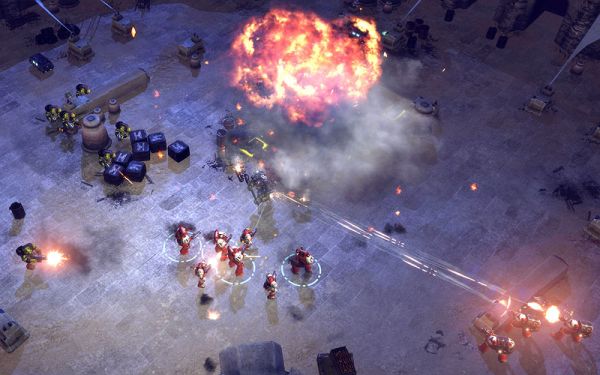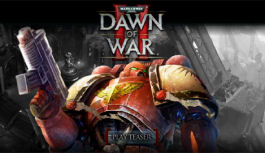As co-op gaming continues to grow, we are seeing it find it's way into other genres. This year we saw realtime strategy game Red Alert 3 create an entire campaign around co-op play; now Relic is entering the fray with Dawn of War 2 for the PC. Promising to deliver drop in and drop out play through the entire campaign in two player co-op is no easy task. We get the goods from the Relic team on how the co-op mode works.
Co-Optimus: With Dawn of War, Company of Heroes, and now Dawn of War II, it seems the RTS genre is finally getting some needed innovations and moving away from the typical "zerg rush" type thinking to a scenario where you're controlling only a few units and the management of those units is critical to success. What lead to this shift in dynamic?
Relic: I wouldn’t say it was one particular thing that led us down this path, but rather, a combination of several.
When we released Company of Heroes we proved that a reduced emphasis on base building, controlling a smaller number of units and using environmental tactics to overcome an opponent – was a successful model. It’s a very rewarding feeling when you use tactics to overcome an opponent with greater numbers, similar to how I imagine the Roman’s felt when giving beat downs to barbarian tribes. When it came time to make a sequel to Dawn of War, we wanted to simply focus on really awesome, over the top but tactical combat.
Typically when you start an RTS game, you might hack a way at a tree for a while, bring wood back to your base, then build a couple of structures and finally send out some units to fight, win that mission and then start over again. Combat as our main focus, we no longer had the need for base building and resource collection. We wanted to instead concentrate on making the units that you do control more exciting and rewarding to use.
Another thing we felt was absent from the RTS genre was any sort of attachment to your units. When you lost a unit or squad it didn’t really matter because you could just build another one exactly like it. RTS games have “mildly” improved on this, generally through veterancy – you’re more likely to focus on keeping your level 3 riflemen alive, as after all they’ve helped you win a few fights at that point and they’re a bit better at killing people. We asked ourselves - what if those squads had names, faces, unique voices and personalities, carried over level to level and could be improved over time – would that make you care more about your units? This kind of unit progression and detail is something you would only see in an RPG, but it fit in with our design goals.
As we were developing the game, we found that the fewer number of squads you controlled the more you could actually focus on your units – it’s positioning, health, energy, when to use certain abilities and when to engage. As soon as we added a fifth squad to the mix, we observed that those of us with less “micro” tended to either start moving everyone around in a giant blob or forgetting about units entirely. Four turned out to be the magic number. After all, these aren’t your typical RTS units, you don’t simply attack move them across the map. Each squad can play quite differently from the other and can be equipped with various different equipment and abilities, meaning that they require that you manage them correctly in order to maximize their destructive capabilities.

Co-Optimus: You mentioned in an interview with IGN that you looked a lot at the multiplayer statistics and noticed how "players want to co-operate in a story-based setting not just in comp-stomp." With the full single player campaign mode in Dawn of War II open to being played co-operatively at any point in the campaign, what can players expect from the play style? RTS mixed with Gears of War 2 Exposition?
Relic: When you actually deploy to the mission you’ll notice that while this is definitely an RTS, it’s one that requires more precise control and positioning over your limited number of specialists. The odds are definitely stacked against you as you’ll often face large waves of mixed units and vehicles; but as a Space Marine that’s just business as usual.
As far as the actual campaign goes - players can expect to play through a non-linear story in which they evolve their characters through unlocks, gear and abilities and choose which missions they take. You start the game as a recently promoted Space Marine commander tasked with defending your main recruiting worlds from being overrun by marauding orks. You quickly discover that there is something more sinister afoot as a cloud of Tyranid Mycetic spores descends over the planet. You’re cut off from reinforcements and it’s up to you to hold out against all odds.
Like most RTS games this sets up an overarching long term goal that you must complete – hold out until help can arrive. Where it differs is that these goals can be tackled in a non-linear order, and even then you can choose to do non-critical missions for other benefits.
Keep in mind that you have a limited number of deployments within a single day (these can be increased) and many of the missions expire within a few days meaning that you will often have to make tough choices. You might be poised with defending two different territories each granting you different advantages in and out of game.
Before each mission you get a briefing detailing why this particular Warboss is fouling up the sector and how it relates to the story. When you’ve deployed to a mission you will hear banter between the squads both relating to the objective and what is happening on the battle field. After you’ve completed a mission you’re usually treated to some new information and / or an update on your overall progress in the sector. By the end of the game you will almost certainly love or hate some of your squad mates, and you may just learn why that salty old jerk Avitus hates the Imperial Guard.
